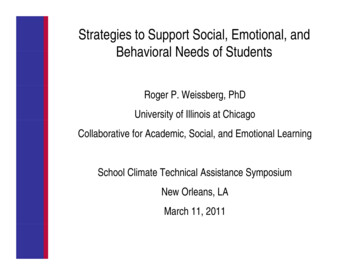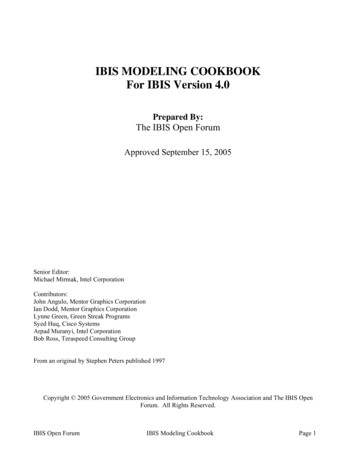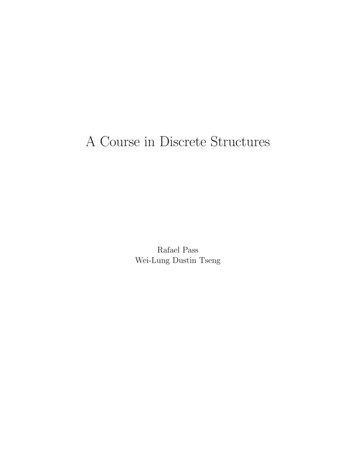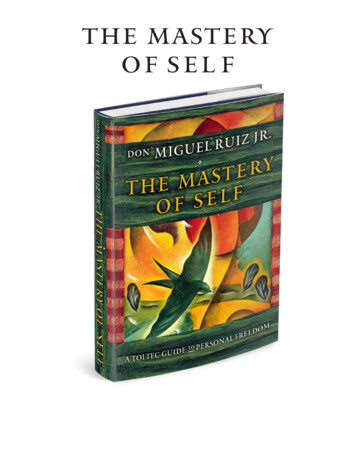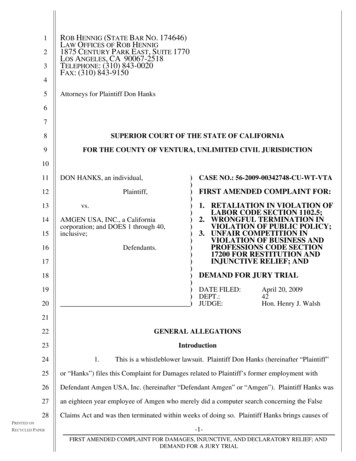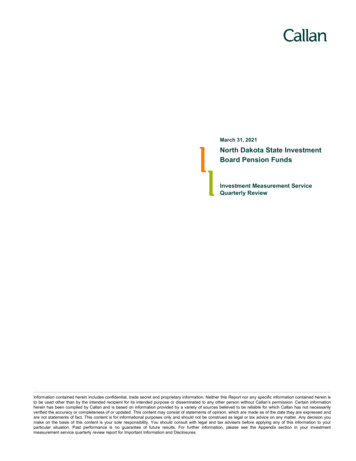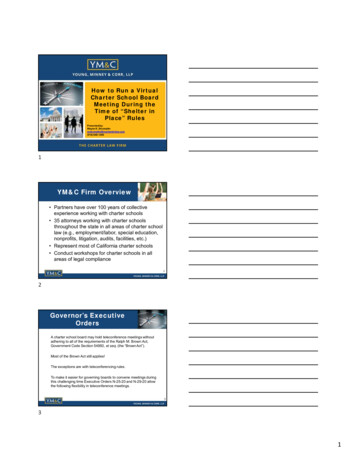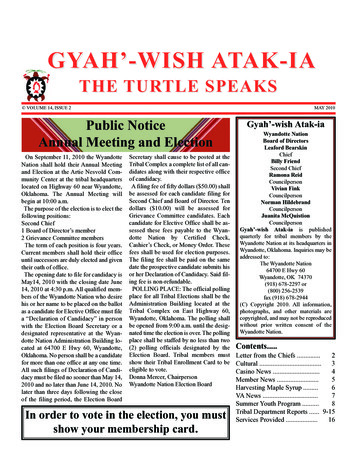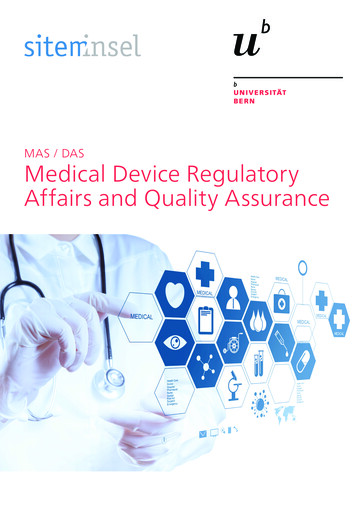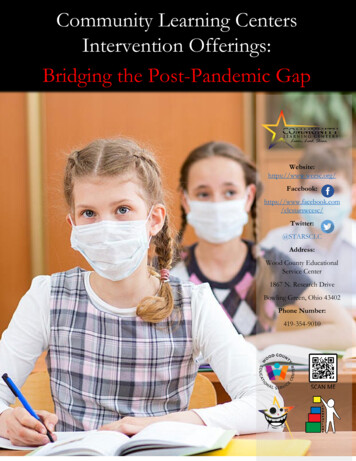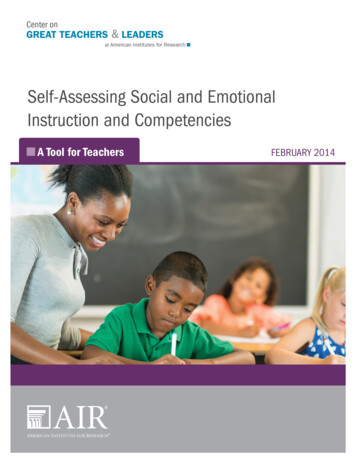
Transcription
Self-Assessing Social and EmotionalInstruction and Competencies:A Tool for TeachersFebruary 2014Nicholas Yoder, Ph.D.1000 Thomas Jefferson Street NWWashington, DC 20007-3835877-322-8700www.gtlcenter.orgThis work was originally produced in whole or in part by the Center on Great Teachers and Leaders with funds from the U.S. Department of Educationunder cooperative agreement number S283B120021. The content does not necessarily reflect the position or policy of the Department of Education, nordoes mention or visual representation of trade names, commercial products, or organizations imply endorsement by the federal government.The Center on Great Teachers and Leaders is administered by American Institutes for Research and its partners: the Council of Chief StateSchool Officers and Public Impact.Copyright 2014 American Institutes for Research. All rights reserved.www.air.org14-1058 02/14
ContentsPageIntroduction .1Overview .2How to Use This Tool .3Section 1: Social Interactions.4Section 2: Instructional Interactions .8Section 3. Scoring, Reflection, and Action Planning.13References .15Appendix A. Ten Teaching Practices That Promote SEL .18Appendix B. Teacher Social and Emotional Competencies .22
IntroductionThe educational community is increasingly focused on the development of students’ social andemotional learning (SEL) competencies and the link between SEL and improved educationalattainment and achievement. SEL is the process through which students develop the skillsnecessary to recognize and manage emotions, build relationships, solve interpersonal problems,and make effective and ethical decisions. The significance of SEL continues to grow in thecontext of policy debates concerning school improvement and individual student achievement.As a result, educators must understand how best to implement the most effective strategies topromote students’ development of SEL competencies. They must understand, too, how to buildand improve their own SEL competencies, because teachers’ social and emotional competenciesdirectly affect how they interact with students on both social and instructional levels.This self-assessment tool is designed to help educators reflect upon (1) their current teachingpractices that impact student SEL, and (2) their own SEL competencies to implement thoseteaching practices. Essentially, the aims of this tool are as follows:!To enable teachers to reflect and self-assess on SEL as an integral part of high-qualityteaching and learning!To provide a broad measure of the teacher’s ability to promote student SEL throughinstructional practices!To provide a mechanism for teachers to reflect on their own SEL competencies and toconsider what impact their capabilities have on the implementation of practices thatsupport SEL!To provide teachers with self-reflective feedback that can be used as part of theirprofessional development plans or educator evaluationsDevelopment of Self-Assessing Social and Emotional Instruction and Competencies: A Tool forTeachers began in 2011 with the goal of characterizing and operationalizing teacher social andemotional competencies (SECs). Staff at American Institutes for Research (AIR) conducted anextensive literature review of teacher SEC and developed a broad definition of the five teacher socialand emotional competencies (see Appendix B for the definitions). In addition, AIR staff interviewedleading experts in the field to obtain their thoughts regarding the definition and operationalization ofteacher SEC. In the context of interviews with teachers in the Chicago and Washington, D.C. publicschools, AIR staff also used the Critical Incident Technique to identify elements of teacher SEC thathelp teachers do their work. This work led to the development of the current tool, which has beenreviewed by teacher SEC experts and state department of education staff whose focus is on social andemotional learning.It should be noted that the tool’s current version was developed to help teachers and school staff selfreflect on their social and emotional competencies and to identify professional learning experiences.The tool has not been empirically tested within a teacher evaluation system. If you would like to usethis tool for evaluative purposes, we highly recommend that you pilot-test it within your state ordistrict.Center on Great Teachers and LeadersSelf-Assessing Social and Emotional Instruction and Competencies:A Tool for Teachers—1
OverviewIn a recent brief produced by the Center on Great Teachers and Leaders (GTL Center), titledTeaching the Whole Child: Instructional Practices That Support Social and Emotional Learningin Three Teacher Evaluation Frameworks, the author identified 10 teaching practices thatpromote social, emotional, and academic skills. These 10 practices can further be divided intotwo types of teaching approaches: those that focus on social teaching practices and those thatfocus on instructional teaching practices (see Figure 1). The GTL Center brief describes how all10 of these practices can facilitate the development of student social, emotional, and academicskills. In addition, the brief demonstrates how these practices align with professional teachingframeworks used in many educator evaluation systems. Definitions and examples of the 10teaching practices are detailed in Appendix A and should be applied as baselines when using thistool.Figure 1. Relationship Between Teacher SEL Skills and the SEL Teaching PracticesStudent-centereddisciplineTeacher Socialand EmotionalSkillsSocialTeachingPracticesTeacher languageResponsibililty andchoiceWarmth and support Self-awareness Self-managementCooperative learning Social awarenessClassroomdiscussionsSelf-assessment andself-reflection Relationship skills Responsibledecision makingInstructionalTeachingPracticesBalanced instructionAcademic press andexpectationsCompetence buildingTo implement these practices successfully, teachers must strengthen their own social andemotional skills. In order to model and encourage positive student interactions, teachersthemselves need the social and emotional skills required to communicate effectively withstudents and to handle stressful situations that can occur in classrooms (Brackett et al., 2009).Teachers who are socially and emotionally competent develop supportive relationships withstudents, create activities that build on the strengths of students, and help students develop thebasic social and emotional skills necessary to participate in classrooms (Jennings & Greenberg,2009). This tool focuses on five teacher social and emotional competencies, including selfawareness, self-management/emotion regulation, social awareness, relationship/social skills, andresponsible decision making (see Appendix B for definitions of the teacher SECs).Center on Great Teachers and LeadersSelf-Assessing Social and Emotional Instruction and Competencies:A Tool for Teachers—2
How to Use This ToolThis tool is divided into the following three sections, with Section 1 and Section 2 each dividedinto two parts:Section 1. Social Interaction AssessmentPart A. Self-assess implementation of teaching practicesPart B. Self-assess teachers’ own SEL competenciesSection 2. Instructional Interaction AssessmentPart A. Self-assess implementation of teaching practicesPart B. Self-assess teachers’ own SEL competenciesSection 3. Culminating Activities and Action PlanningSections 1 and 2, Part A—Educators have the opportunity to self-assess on the teachingpractices outlined in Figure 1 above. Section 1 focuses on social interactions, and Section 2focuses on instructional interactions.Ratings are based on how often and how well educators implement each practice on a scale of 1to 5, from “I do not implement this practice” to “I implement this practice extremely well.”1—I do not implement this practice: I am not implementing these practices.2—I struggle to implement this practice: I sometimes attempt to implement thesepractices, and when I do, I have a difficult time implementing them.3—I implement this practice reasonably well: I attempt to implement these practicesand do a reasonable job. I think with more practice and/or some support, I couldimplement these practices well.4—I generally implement this practice well: I implement these practices well on aregular basis. These practices are not implemented perfectly, but my students benefitwhen I implement them.5—I implement this practice extremely well: I consider these practices to be amongmy regular practices. I use these practices all of the time, and they are highly successfulwith my students.Sections 1 and 2, Part B—Educators consider their own SECs and how their SECs influencetheir ability to implement (1) social teaching practices, and (2) instructional teaching practices.Teachers will rate their SECs on a four-point scale, from 1 “strongly disagree” to 4 “stronglyagree”.Section 3—Total scores are computed, and educators can reflect on their self-ratings withguidance from questions and points provided for further consideration.11For additional resources and next steps, please see the professional learning module (PLM) on social andemotional learning on the GTL Center’s website (http://www.gtlcenter.org/). This PLM is forthcoming.Center on Great Teachers and LeadersSelf-Assessing Social and Emotional Instruction and Competencies:A Tool for Teachers—3
Section 1: Social InteractionsPart A. Teaching Practices. Think about how often you implement a variety of practices thatinfluence students’ social, emotional, and academic skills. Think about how often you implementteaching practices that focus on positive social interactions. Using a scale of 1 to 5, rate howoften and how well you use these practices.1—I do not implement this practice4—I generally implement this practice well2—I struggle to implement this practice5—I implement this practice extremely well3—I implement this practice reasonably well1. Student-Centered DisciplineSEL PracticesSelf-RatingCommentsSelf-RatingCommentsa. I have discussions with my students about how andwhy classroom procedures are implemented.b. I implement consequences that are logical to the rulethat is broken.c. I am consistent in implementing classroom rules andconsequences.d. I respond to misbehavior by considering pupilspecific social, affective, cognitive, and/orenvironmental factors that is associated withoccurrence of the behavior.e. I hold class discussions with my students so we cansolve class problems.f.I ask my students to reflect and redirect theirbehavior when they misbehave.g. I teach students strategies to handle the emotions thataffect their learning (e.g., stress, frustration).h. I model strategies that will help students to monitorand regulate their behavior.2. Teacher LanguageSEL Instructional Practicesa. I promote positive behaviors by encouraging mystudents when they display good social skills (e.g.,acknowledge positive actions or steps to improve).b. I promote positive behaviors by encouraging mystudents when they display good work habits (e.g.,acknowledge positive actions or steps to improve).c. I let my students know how their effort leads topositive results with specific affirmation.Center on Great Teachers and LeadersSelf-Assessing Social and Emotional Instruction and Competencies:A Tool for Teachers—4
3. Responsibility and ChoiceSEL Instructional PracticesSelf-RatingCommentsSelf-RatingCommentsa. I let my students help plan how they are going tolearn in developmentally appropriate ways.b. I ask for student input when making decisions abouthow the classroom will operate in developmentallyappropriate ways.c. I give students meaningful choices (with parameters)on what they can work on.d. I make sure students make the connection betweentheir choices and potential consequences.e. I arrange experiences that allow my students tobecome responsible (e.g., classroom aids or jobs, peertutoring, specific roles in group work) indevelopmentally appropriate ways.4. Warmth and SupportSEL Instructional Practicesa. I demonstrate to each student that I appreciate him orher as an individual (e.g., appropriate eye-contact,greeting each child by name).b. I use the interests and experiences of my studentswhen teaching.c. I display to my students that I care about how andwhat they learn.d. I let my students know that it is okay to get answerswrong or think outside of the box (e.g., modeling,praising attempts with “good thinking”).e. I check in with my students about academic andnonacademic concerns they might have.f.I follow up with my students when they have aproblem or concern.g. I create structures in the classroom where mystudents feel included and appreciated (e.g., morningmeetings, small moments, whole-class share outs).Center on Great Teachers and LeadersSelf-Assessing Social and Emotional Instruction and Competencies:A Tool for Teachers—5
Part B. Teacher Social and Emotional Competencies. Now think about your own social andemotional competencies and how those competencies influence your ability to implement thesocial interaction teaching practices. Please use the scoring guide below to rate yourself on howyour SEL skills influence your social interaction teaching practices with your students. Considereach statement and score yourself according to where each statement holds true for you.1 Strongly disagree. I have a difficult time with this practice. I know I do some of thethings mentioned, but I do not necessarily find them relevant to my teaching.2 Disagree. I demonstrate some of these skills with my students. I think with morepractice and/or more support, I could demonstrate these skills more to improveimplementation of this practice.3 Agree. I am strong in this area. I know I do a good job modeling these skills for mystudents. I use these skills most of the time when I implement the instructional practices.4 Strongly agree. I am very strong in this area. I am able to use these skills when I amimplementing the instructional reeStronglyagreeI am aware of social teaching practices that I need to improve uponand grow professionally.1234I can effectively implement social teaching practices with mystudents.1234I am usually aware of how my emotions, culturally grounded beliefs,and background are precursors to my emotional reactions, and Iunderstand how they impact my social teaching practices with mystudents.1234I understand how student responses (positive and negative) affect myemotions and my behaviors during social teaching practices.1234I am aware of how my cultural beliefs and background affect mysocial teaching practices with my agreeI continuously refine my personal goals about how I will bestimplement social teaching practices with my students.1234I effectively use multiple strategies (e.g., breathing techniques andmindfulness) when I have a strong emotional reaction in the classroom(e.g., stress, anger) when implementing social teaching practices.1234Through the effective management of my emotions (e.g., use of stressreduction techniques), I am better able to implement social teachingpractices, use positive approaches to discipline, and develop a positivelearning environment that is free from bias and prejudice.1234I model behaviors (e.g., form guidelines, set boundaries) to helpstudents learn to regulate emotions during social teaching practices.1234Self-Management/Emotion RegulationCenter on Great Teachers and LeadersSelf-Assessing Social and Emotional Instruction and Competencies:A Tool for Teachers—6
Social eTo effectively implement positive social teaching practices, I usuallyunderstand the perspectives of my students and can pay attention totheir emotional cues during classroom interactions.1234I try to understand why my students are or are not activelyparticipating, and I am usually successful at providing my students thenecessary skills to participate in the social teaching practices.1234I successfully support positive emotions and respond to negativeemotions during social teaching practices.1234I address the commonalities and differences (e.g,. racial, ethnic,cultural) that exist among students when I implement the socialteaching yagreeI clearly communicate behavioral and academic expectations in amanner that addresses students’ individual needs and strengths whenimplementing social teaching practices.1234I am comfortable helping my students resolve interpersonal conflictsthat come up during social teaching practices, and I have experiencedsuccess with this.1234I use the social teaching practices to help form meaningfulrelationships with my students and cultivate their SEL skills, and I amusually successful at building meaningful relationships.1234I use the social teaching practices to help cultivate my students’ SELskills, and I am usually successful at building their SEL reeI am effective at considering multiple forms of evidence, such asbalancing the needs and the behaviors of my entire class, whileimplementing the social teaching practices.1234I regularly include my students and/or collaborate with colleagues tosolve problems that arise in the classroom related to the socialteaching practices.1234I stay focused and consistent when I implement social teachingpractices.1234When I implement the social teaching practices, I balance students’emotional needs and academic needs.1234Relationship/Social SkillsResponsible Decision MakingCenter on Great Teachers and LeadersSelf-Assessing Social and Emotional Instruction and Competencies:A Tool for Teachers—7
Section 2: Instructional InteractionsPart A. Teaching Practices. Think about how often you implement a variety of practices thatinfluence students’ social, emotional, and academic skills. Think about how often you implementteaching practices that focus on positive instructional interactions. Using a scale of 1 to 5, ratehow often and how well you use these practices.1—I do not implement this practice4—I generally implement this practice well2—I struggle to implement this practice5—I implement this practice extremely well3—I implement this practice reasonably well5. Cooperative Learning/Group LearningSEL Instructional PracticesSelf-RatingCommentsSelf-RatingCommentsa. I encourage my students to work with other studentswhen they have trouble with an assignment.b. I create learning experiences in which my studentsdepend on each other.c. I create learning experiences in which my studentsmust apply positive social skills to be successful.d. I hold individuals and the group accountable forlearning during small-group work.e. I provide opportunities for my students to share theirwork and receive feedback from each other.f.I provide space to allow my students tocollaboratively process how they work together andmonitor their progress toward their goal.g. I give students feedback on how they interact withand learn from others during cooperative learningexperiences.6. Classroom DiscussionsSEL Instructional Practicesa. I help my students identify how to listen (e.g.,tracking the speaker, making mental connections).b. I help students learn how to respond to and learnfrom their peers’ contributions during a discussion.c. I help my students learn how to effectivelycommunicate their points of view (e.g., elaborate ontheir thinking).d. I hold in-depth discussions about content with mystudents.e. I ask my students to listen to and think about theirpeers’ opinions and whether they agree with them.Center on Great Teachers and LeadersSelf-Assessing Social and Emotional Instruction and Competencies:A Tool for Teachers—8
7. Self-Assessment and Self-ReflectionSEL Instructional PracticesSelf-RatingCommentsSelf-RatingCommentsa. I tell my students the learning goals for each lesson.b. I have my students reflect on their personal academicgoals (e.g., make connections to the lesson goals).c. I provide my students strategies to analyze their work(e.g., using performance rubrics, peer reviews).d. I create opportunities for my students to monitor andreflect on their progress toward their learning goals.e. I create opportunities for my students to monitor andreflect on their social learning.f.I help my students develop strategies to make surethey meet their learning goals.g. I provide my students opportunities to reflect on theirthinking and learning processes (e.g., using graphicorganizers or journals).h. I ask my students to think together to providefeedback on the effectiveness of learning activities(e.g., debriefing tool, feedback form, simple survey).8. Balanced InstructionSEL Instructional Practicesa. I use an appropriate balance between providingstudents opportunities to directly learn newinformation, as well as actively engage in thematerial.b. I have my students work on some extended projectsthat require at least one week to complete.c. I require my students to extend their thinking whenthey provide basic answers (e.g., ask multiple followup questions).d. I use multiple instructional strategies to keep mystudents engaged in learning.e. I make sure that my activities are not just fun, butrepresent one of the best ways for students to learnthe content.f.I ask students to work on products (e.g., Web pages,skits, or posters) that are meant to be shared withmultiple audiences (e.g., parents, communitymembers).Center on Great Teachers and LeadersSelf-Assessing Social and Emotional Instruction and Competencies:A Tool for Teachers—9
9. Academic Press and ExpectationsSEL Instructional PracticesSelf-RatingCommentsa. I give my students more challenging problems whenthey have mastered easier material.b. I ensure that my students feel responsible foraccomplishing or failing to accomplish theiracademic work.c. I teach my students the connection between effortand results, and I expect my students to put in fulleffort.d. I give my students work that has more than one rightanswer and ask them to defend their answerse. I support my students socially and emotionally whilechallenging them with new or higher levels oflearning.10. Competence Building—Modeling, Practicing, Feedback, and CoachingSEL Instructional PracticesSelf-RatingCommentsa. I model and practice new learning with my studentsbefore asking them to perform independently.b. I demonstrate a concept using a variety of tools (e.g.,modeling, demonstrations, mini-lessons, or texts).c. I conference with my students on ways to make theirwork better.d. I use multiple strategies with my students until theyhave figured out how to solve the problem (i.e.,graphic organizers, leveled text, checklist, verbalcues).e. I give my students frequent specific feedback to letthem know how they are doing in my class(academically and socially).f.I have my students correct their mistakes (academicor social) based on feedback from me or their peers.g. I provide specific feedback that is focused on theacademic task at hand.h. I use student misconceptions to guide my instructionwithout singling the student out.Center on Great Teachers and LeadersSelf-Assessing Social and Emotional Instruction and Competencies:A Tool for Teachers—10
Part B. Teacher Social and Emotional Competency. Now think about your own social andemotional competencies and how those competencies influence your ability to implement theinstructional interaction teaching practices. Please use the scoring guide below to rate how yourSEL skills influence your instructional interaction teaching practices with your students. Considereach statement and score yourself according to where each statement holds true for you.1 Strongly disagree. I have a difficult time with this practice. I know I do some of thethings mentioned, but I do not necessarily find them relevant to my teaching.2 Disagree. I demonstrate some of these skills with my students. I think with morepractice and/or more support, I could demonstrate these skills more to improveimplementation of this practice.3 Agree. I am strong in this area. I know I do a good job modeling these skills for mystudents. I use these skills most of the time when I implement the instructional practices.4 Strongly agree. I am very strong in this area. I am able to use these skills when I amimplementing the instructional reeStronglyagreeI am aware of instructional teaching practices that I need to improvein order to grow professionally.1234I can effectively implement instructional teaching practices with mystudents.1234I am usually aware of how my emotions, culturally grounded beliefs,and background are precursors to my emotional reactions, and Iunderstand how they impact my instructional teaching practices withmy students.1234I understand how student responses (positive and negative) affect myemotions and my behaviors during instructional teaching practices.1234I am aware of how my cultural beliefs and background affect myinstructional teaching practices with my agreeI continuously refine my personal goals about how I will bestimplement instructional teaching practices with my students.1234I effectively use multiple strategies (e.g., breathing techniques andmindfulness) when I have a strong emotional reaction in the classroom(e.g., stress, anger) when implementing instructional practices.1234Through the effective management of my emotions (e.g., use of stressreduction techniques), I am better able to implement instructionalteaching practices and to develop a positive learning environment thatis free from bias and prejudice.1234I model behaviors (e.g., form guidelines, set boundaries) to helpstudents learn to regulate emotions during instructional practices.1234Self-Management/Emotion RegulationCenter on Great Teachers and LeadersSelf-Assessing Social and Emotional Instruction and Competencies:A Tool for Teachers—11
Social eTo effectively implement positive instructional teaching practices, Iusually understand the perspectives of my students and can payattention to their emotional cues during classroom interactions.1234I try to understand why my students are or are not activelyparticipating, and I am usually successful at providing my students thenecessary skills to participate in the instructional teaching practices.1234I successfully support positive emotions and respond to negativeemotions during instructional teaching practices.1234I address the commonalities and differences (e.g,. racial, ethnic,cultural) that exist among students when I implement theinstructional teaching yagreeI clearly communicate behavioral and academic expectations in amanner that addresses students’ individual needs and strengths whenimplementing instructional teaching practices.1234I am comfortable helping my students resolve interpersonal conflictsthat come up during instructional teaching practices, and I haveexperienced success with this.1234I use the instructional teaching practices to help form meaningfulrelationships with my students and cultivate their SEL skills, and I amusually successful at building meaningful relationships.1234I use the instructional teaching practices to help cultivate mystudents’ SEL skills, and I am usually successful at building their yagreeI am effective at considering multiple forms of evidence, such asbalancing the needs and the behaviors of my entire class, whileimplementing the instructional teaching practices.1234I regularly include my students and/or collaborate with colleagues tosolve problems that arise in the classroom related to the instructionalteaching practices.1234I stay focused and consistent when I implement instructional teachingpractices.1234When I implement the instructional teaching practices, I balanceawareness of students’ emotional needs and academic needs.1234Relationship/Social SkillsResponsible Decision MakingCenter on Great Teachers and LeadersSelf-Assessing Social and Emotional Instruction and Competencies:A Tool for Teachers—12
Section 3. Scoring, Reflection, and Action Planning1. In the box below, indicate the score you received for each of the 10 instructional practices. Inorder to create a final score for each practice, take the average of the scores under eachpractice.Instructional PracticeYour Score/TotalPossible Points1. Student-Centered Discipline/352. Teacher Language/153. Responsibility and Choice/254. Warmth and Support/355. Cooperative Learning/356. Classroom Discussions/257. Self-Reflection and Self-Assessment/408. Balanced Instruction/309. Academic Press and Expectations/2510. Competence Building/40Average Score2. Reflect on your scores.1. On which SEL practices did you score thehighest? Why?2. On which SEL practice did you score thelowest? Why?3. What evidence do you have to support theself-ra
Part A. Self-assess implementation of teaching practices Part B. Self-assess teachers’ own SEL competencies Section 3. Culminating Activities and Action Planning Sections 1 and 2, Part A—Educators have the opportunity to self-assess on the teaching practices outlined in Figure 1 above
